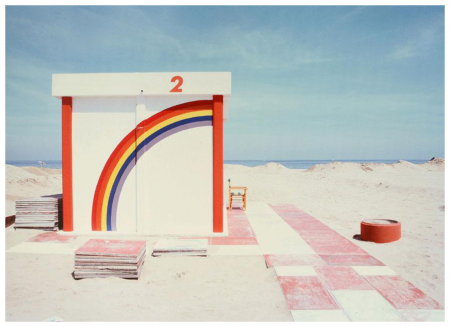Catalog essay for Luigi Ghirri
Exhibition, Julie Saul Gallery, 2001
It is always great folly to write about photographs, for the experience of them always transcends description. This is particularly true of really enigmatic photographs such as those of Luigi Ghirri. Like all good art, Ghirri’s photographs are not about specific things but transfer into their content, the process by which they were made. Thus I cannot address the photographs individually but instead ask the viewer to consider them carefully, particularly in their relation to each other. The statement made by a single image can never be as powerful as that made by an entire body of work. This is particularly true of Ghirri’s oeuvre as he photographed in sequences and patterns making the meaning of the photographs the synergistic experience of several themes.Ghirri’s subject matter, for lack of any other way to describe

it, is the travelogue of Italy in the latter day twentieth century. As Heinrick Heine put it in his Journeys Into Italy, “there is nothing so stupid on the face of the earth as to read a book of travels in Italy—unless it is to write one.” Ghirri reminds me of Heine; he mocks his own Viaggio in Italia disclaiming the wonders for the pedestrian delights.For me, Ghirri represents in his persona and his remarkable but short-lived life all that is wondrous in Italian culture. I first met him over twenty years ago when he guided me in my own photographic adventures through Italy. He was then, as he symbolically is now, the catalyst for serious photographic activity in that country. He introduced me and other foreigners interested in the activities of our fellow photographers to a large number of young, energetic image makers who, like Ghirri, were dissecting the physical and cultural topography of their environs.
Like a Don Quixote, Ghirri traveled relentlessly by car or train around his country, madly in the quest of his own inspiration but also for a livelihood which he made through freelance commissions, consulting jobs and curatorial work. I saw him unshaven, elegantly wrinkled in the way that only an intellectual Italian can be. Gesturing about on an unrealistic time schedule, he was reflective of the frenetic incongruities he depicted. We were good friends, simpatico and totally in sync without understanding a word of each others language. He was an unfailing energy, seriously snapshooting to the end.In the eighties, with my fellow writer, Luigi Ballerini, I embarked on a visual and literary look at Italy in my own book Italy Observed. It was Ghirri whose work opened the doors to the rich contemporary photographic work ignored by the American cognoscenti (MimmoJodice, OlivoBarbieri, Gabriele Basilico and many others). While even today Ghirri’s work goes largely unsung, it remains as significant as his better known American contemporaries (Steven Shore, William Eggleston, Robert Adams). Perhaps in the decade and a half when Ghiri worked, the curatorial interests overlooked wit for the detached, dispassionate, cool eye. Ghirri’s work though manifesting some of those same photographic interests anticipated something else. His concerns were postmodern before those words were bandied about in photographic circles. He believed not in photographic truths but in the act of photographing as a social phenomenon, as a means of deconstructing the landscape and reinventing a hyper realistic space. Remarkably, his work also foretold a facet of another genre to come. His images are diaristicnotations of a passage through typologies that reveal a kind of collector’s mania. Unlike many of today’s obscurely narcissistic works, however, Ghirri’s does not require his interpretive presence for one to understand the cultural life and muse of post-modern Italy which drove him.Luigi Ghirri saw the multiple personalities of Italy through the signs of its many layered civilizations. Ballerini and I broke Italian culture down into six categories, each of which are archetypally represented in Ghirri’s photographs and can be well understood through them.
Fabulous Graces is his portrait of the enduring forces that shape Italy’s Genius loci.This Figured Myth is Ghirri’s expression of a country suffering from the insecurity of a modern and now unisolated culture.Shattered Illusions is the irreconcilable rift between myth and its erosion in his photographs.Extant Realism is that hyper focus in Ghirri’s photographs that is but one face of illusion’s coin.Resurrected Legends is Ghirri’s concern that his imagination can only expand as he continued looking into Italy’s layered archeology.Eternal Charms is the paradoxical ethos of Italian daily life. As the faces of the coin are indistinguishable in his images.